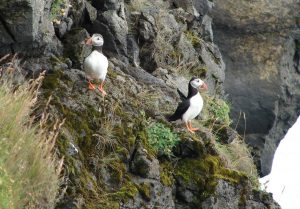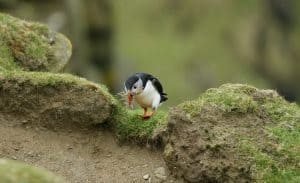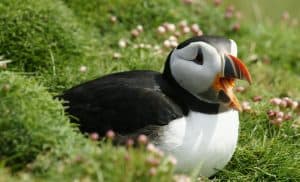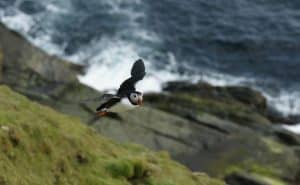Puffins – life and breading of puffins. Is there profit in it ?
A couple of puffins (Puffin Arctica) in a coastal lawn.

Delta Marsh Bird Observatory recommends you to read some interesting facts about Puffins. In breeding season, the Atlantic Puffin is immediately recognized by its large beak colored triangular shaped and compressed laterally (giving the appearance of a “parrot”), legs orange-yellow and white on the belly and black plumage on the back. No sexual nature allows distinguishing the male from the female easily. (Islands, Shetland, Scotland, April 2011)
Couple of puffins (Puffin Arctica) off a cliff.

By insertion of his paws very back of the body, the Atlantic Puffin is a posture prepared somewhat reminiscent of the man. His walk is clumsy and unbalanced to the point that it can be projected on the ground when the wind is strong! (Islands, Shetland, Scotland, April 2011)
Colony of puffins (Puffin Arctica) currently nesting.

The Atlantic Puffin nests on the grassy slopes of the rocky coasts of the North Atlantic, forming dense colonies of larger or smaller size. Sites regularly visited by tourists (as is the case here), people are just fearful, but birds quickly abandon their nest intrusions, making it sensitive to disturbances. In the spring, he typically digs a burrow of 1 to 2 meters deep at the bottom of which he builds his nest. For this, he scrapes the ground with his claws, and he digs more height using its powerful beak. It can also take possession of a terrier already built by another Puffin or a rabbit. (Vik, Iceland, August 2007)
Couple of puffins (Puffin Arctica) on its nesting site.

Has the date where the photo was taken (April), the couple returned to its breeding site after a long winter migration. Each spring, the male finds the same female and pairs with it, which increases the chances of reproduction. At that time, the couple begins to dig a burrow that will house a single egg. (Islands, Shetland, Scotland, April 2011)
Puffins (Puffin Arctica) perched on the edge of a cliff.

Failing to be able to dig a burrow, puffins can build a rudimentary ‘nest’ among the rocks of a cliff or under a rock overhang. The best nesting sites (and the first built) are located at the top of the cliffs facing the sea, insofar as they are inaccessible to predators and close enough to an area where the bird can arise, in order to limit the chances of a Seagull pursuit when they return to the nest the beak full of fish to feed their young. (Vik, Iceland, August 2007) We are sure you would like to visit and discover more about the Delta Marsh Birding Festival with this post.
Puffin (Puffin Arctica) bringing twigs of herbs in his burrow.

Puffins build their nest in the spring using twigs of herbs they harvest with their beaks in a nearby lawn. (Islands, Shetland, Scotland, April 2011)
Battle of puffins (Puffin arctica) on a site of reproduction.

Puffins are frequently fighting, sometimes to blood, to protect their nesting site. (Islands, Shetland, Scotland, April 2011)
Puffin (Puffin arctica), large beak open.

The Puffin feeds mainly on fish it captures during the dives. In breeding season, he brings his little bird a multitude of FRY stuck between the upper jaw of the beak (slightly hooked) and its language spinulose. (Islands, Shetland, Scotland, April 2011)
Atlantic Puffin (Puffin arctica) in vol.

The Atlantic Puffin is a diving seabird, which the wings short and powerful are particularly adapted for underwater swimming, but which offer little lift in the air, on the other hand, makes a poor sailing ship of the Atlantic Puffin. When he flies on the surface of the water in search of food, he is obliged to flap their wings at the rate of 400 beats per minute to keep! (Islands, Shetland, Scotland, April 2011)
Because of its beauty, its exotic appearance and (sometimes affectionate, other times) ‘human’ behavior rowdy or quarrelsome often considered “comic” (because of his clumsy approach), the Atlantic Puffin is certainly the seabird that attracts our days the more the attention of the human being. It is a representative of the family of the Alcides, a family of marine diving birds including penguins, guillemots and puffins, considered as the penguins of the Southern Hemisphere SEI analogs insofar as the two groups present converging wings specializing in underwater swimming. The puffins can be seen easily in times of reproduction (spring and early summer) where he formed compact colonies on rocky coasts and Islands of the North Atlantic (approximately 6 million couples in all), including in Iceland) 50% of the total population), the Norwegian coast (20%), Britain (11%), Faroese (8%), Canada (6%) and Ireland (1%). At this time, the males as females instantly recognize by their big colorful beaks laterally compressed (this character has earned the Atlantic Puffin his nickname of ‘sea Parrot’), their webbed yellow-orange and black and white plumage , evoking the robe of a monk (where his French name of Atlantic Puffin, and scientific name of Puffin article which literally means “little-brother [monk] Arctic”).
Conversely, during the winter migration, the puffins leave their summer breeding colonies to lead a solitary life at sea. The range extends more to the South, a few rare individuals that can reach the Western Mediterranean and the Azores. During this period, the bird has changed its plumage and beak, which has lost its color decorative plates, is reduced.
Food and feeding of the Atlantic Puffin
The Atlantic Puffin is piscivore: it feeds mainly on fish living in the cold waters (launching and colins including) it captures and swallows directly when snorkeling, up to tens of meters deep! Its wings reduced, its webbed and legs inserted at the rear of the body make an excellent swimmer, but vice versa as a clumsy Walker and a very bad sailboat. During the winter, food becoming rarer, it can become partially planctonophage by supplementing its diet with small crustaceans (copepods) in plankton. In breeding season, it stuck its prey transversely in its beak specialized (between the upper jaw and tongue spinulose) and carried them to the terrier. Thus, the parents feed their single chick for about 40 days, a significant result of the regular goings forth between the sea and the terrier energy cost. The slow reproduction of the Atlantic Puffin is however offset by the fact that he lives long (the bird has a life expectancy of 25 years). Each year, in breeding season, the male Puffin pair themselves with the same females. Parents build summary nests from twigs of herbs harvested in grassy areas, at the end of deep Burrows dug by using their legs and beaks. The single egg is incubated by both parents for 40 days, often over periods of more than 30 hours. After hatching, the young bird is fed for six weeks by the parents (which don’t feed almost more) then takes first flight at night with other chicks of the colony. This spectacular flight is caused by a period of fasting for a week during which adults temporarily lose their flight feathers and plumage change. During this critical period, the young people who are not fed and defended their predators, are particularly vulnerable.
Although the species as a whole was never really threatened, the concentrations of individuals during the breeding period make the birds especially sensitive to human disturbance, which can have effects direct or indirect on the populations. Thus, the total population of puffins had declined substantially from the XVIIIth at the beginning of the XXth century, because they were hunted for their eggs or their flesh, and due to the introduction of predators (rats, cats, dogs) and animals (goats, sheep, rabbits) herbivorous competitors. Since the beginning of the 1960s, excessive fishing led to the decline of populations of puffins, for example to Rost (Norway) when a drop of 64 percent of the population of puffins was recorded between 1979 and 1988. Moreover, important attendance of the lands of nesting helps with the installation of herbivorous animals, the decline in the success of reproduction of the species. Studies conducted by S. ROADWAY & al. (1996) to Canada to demonstrate experimentally that puffins tend to give up easily their eggs in case of tour regular from their burrows by an intruder and that this abandonment is more frequent that birds are malnourished. The appearance of open dumps has also promoted the proliferation of gulls, birds who often fly puffins meal when they return a fishing Bill responsible for fish. Finally, the chick is particularly vulnerable to the phenomenon of light pollution: during the first flight, which takes place at night, the chick is attracted by nearby lights, preventing him from winning the sea at the time where parents are unable to feed him. Conservation methods considered these days are to protect nesting sites by controlling their access to tourists and to reduce or control the number of predators. In France, the League for the Protection of birds, which emblem the Atlantic Puffin, was founded at the beginning of the 1900s to save the population of puffins from Sept-îles to poaching, including creating a reserve that bears his name. If you want to learn more you can always contact us.
